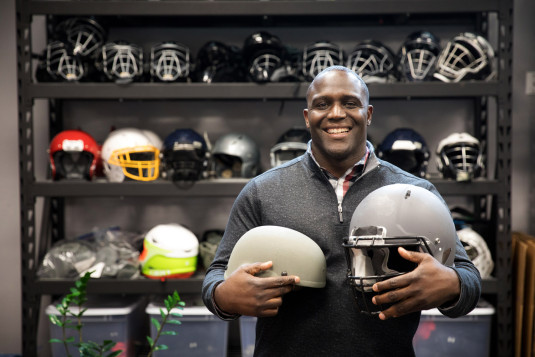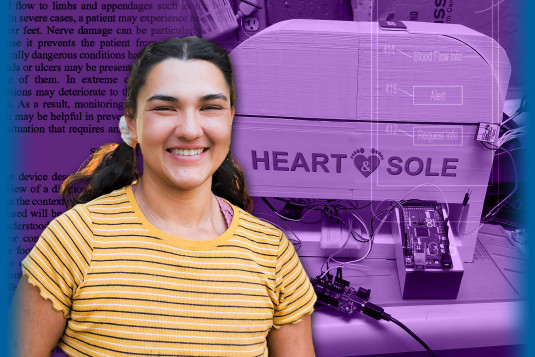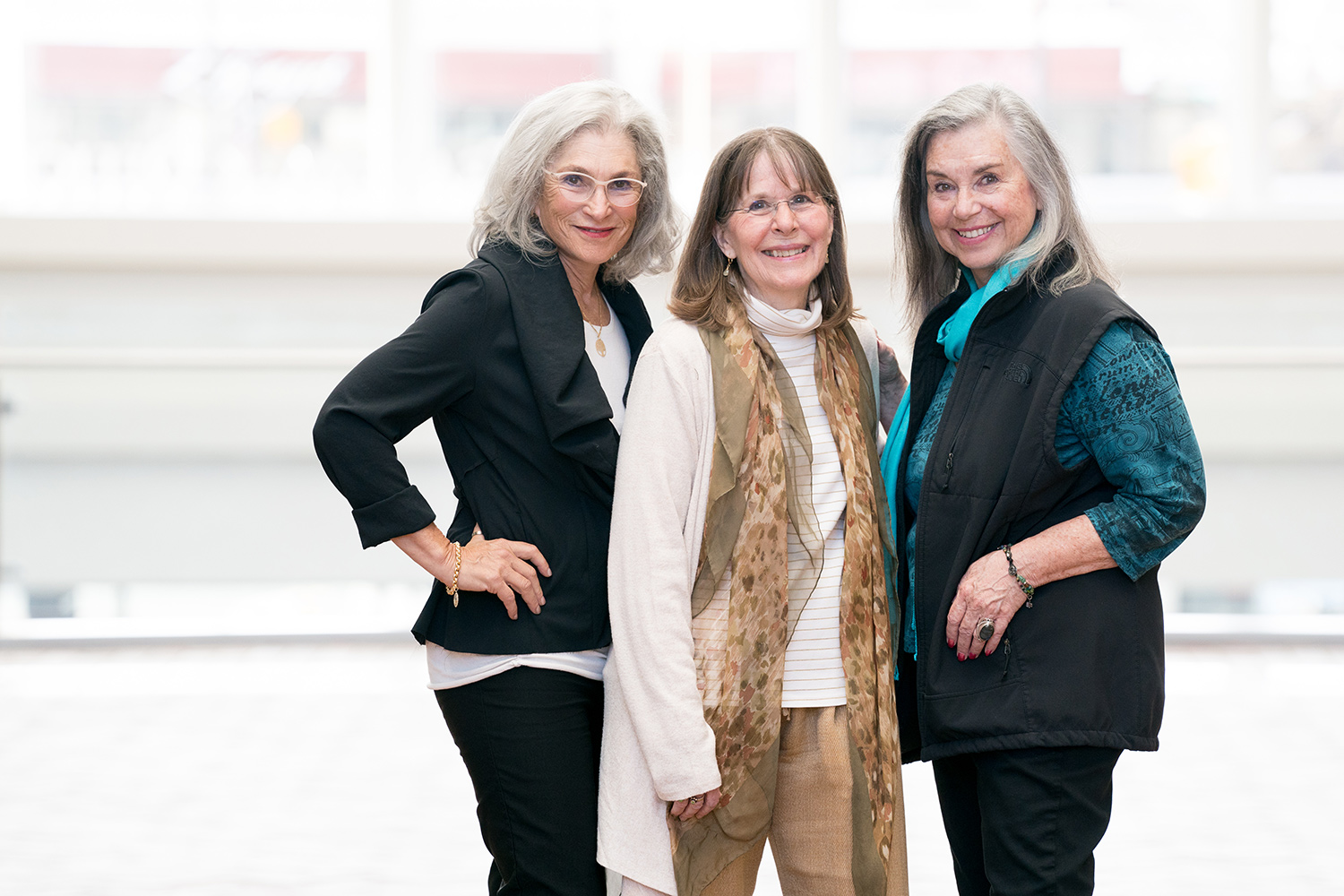
Establishing the new fit
Hinda Miller, Polly Smith, and Lisa Lindahl designed the sports bra in the 1970s to decrease discomfort for female runners. Since then, their invention has become a necessity for female athletes and a modern fashion staple. The empowering story of these three women offers a compelling example of determination, ingenuity, and creativity.
The inventors’ creation, the Jogbra, will be shown at the Smithsonian Institution’s new “Change Your Game” exhibit that will open at the National Museum of American History in Washington D.C., on March 15. The exhibit shares stories of inventors and their motivations for creating new sports technologies, and it encourages visitors to become game changers in their everyday lives.
13 min read
Each month, our Journeys of Innovation series tells the stories of inventors or entrepreneurs whose groundbreaking innovations have made a positive difference in the world. This month, Lauren Emanuel's story focuses on the journey of the three women who invented the sports bra.
In 1979, Lisa Lindahl, Hinda Miller, and Polly Smith received U.S. Patent No. 4,174,717 for the athletic brassiere, or “Jogbra.” More than 40 years after their invention, they gathered in the National Inventors Hall of Fame Museum in Alexandria, Va. to discuss their experiences as pioneers in the women’s fitness industry and to reminisce about their days as young friends and creators.
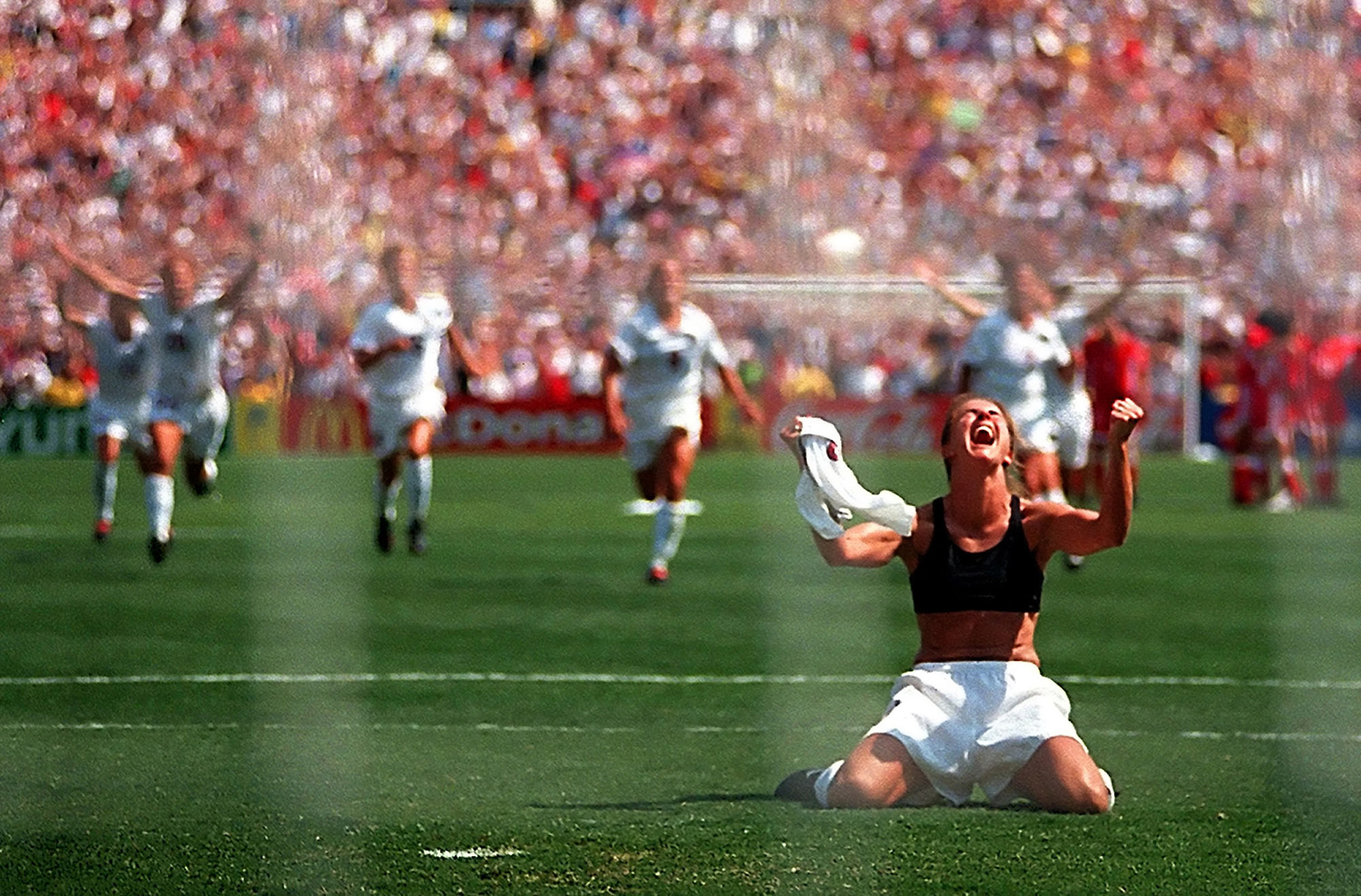
In 1999, Brandi Chastain, player on the U.S. Women’s National Team, scored the winning penalty kick in the Women’s World Cup final. She celebrated by taking off her jersey. According to the Washington Post, “Chastain sees the sports bra—and the iconic pictures of her baring hers—as a key part of the female journey [from] athletic afterthought to athletic equal.” Photo courtesy of Branimir Kvartuc/ZUMA/isiphotos.com.
Lindahl, 71, an entrepreneur, author, artist, and women’s health advocate, says the motivation for the Jogbra started with a blunt question from her sister in 1977 about the discomfort she experienced while running: “Why isn’t there a jockstrap for women?”
“A 30-mile a week runner myself, I told her I had no good answer about how to solve the problem,” says Lindahl, “and we were complaining that there was no good answer. When I hung up the phone, I went, well, why not make one? And I wrote down the design specifics such a garment would need. But I don’t sew!”
Fortunately, Lindahl already knew the right women to help with the job. Polly Smith, 70, Lindahl’s childhood friend and now an award-winning costume designer, was renting a room from her back then while working as a lead costume designer at the Champlain Shakespeare Festival in Vermont. Hinda Miller, 70, an entrepreneur, author, business coach, frequent corporate and higher education board member, and a Vermont state senator from 2003-2012, was also then working at the festival as an assistant costume designer for Smith.
"My body and I had a complicated relationship, but running changed it. I loved it.”
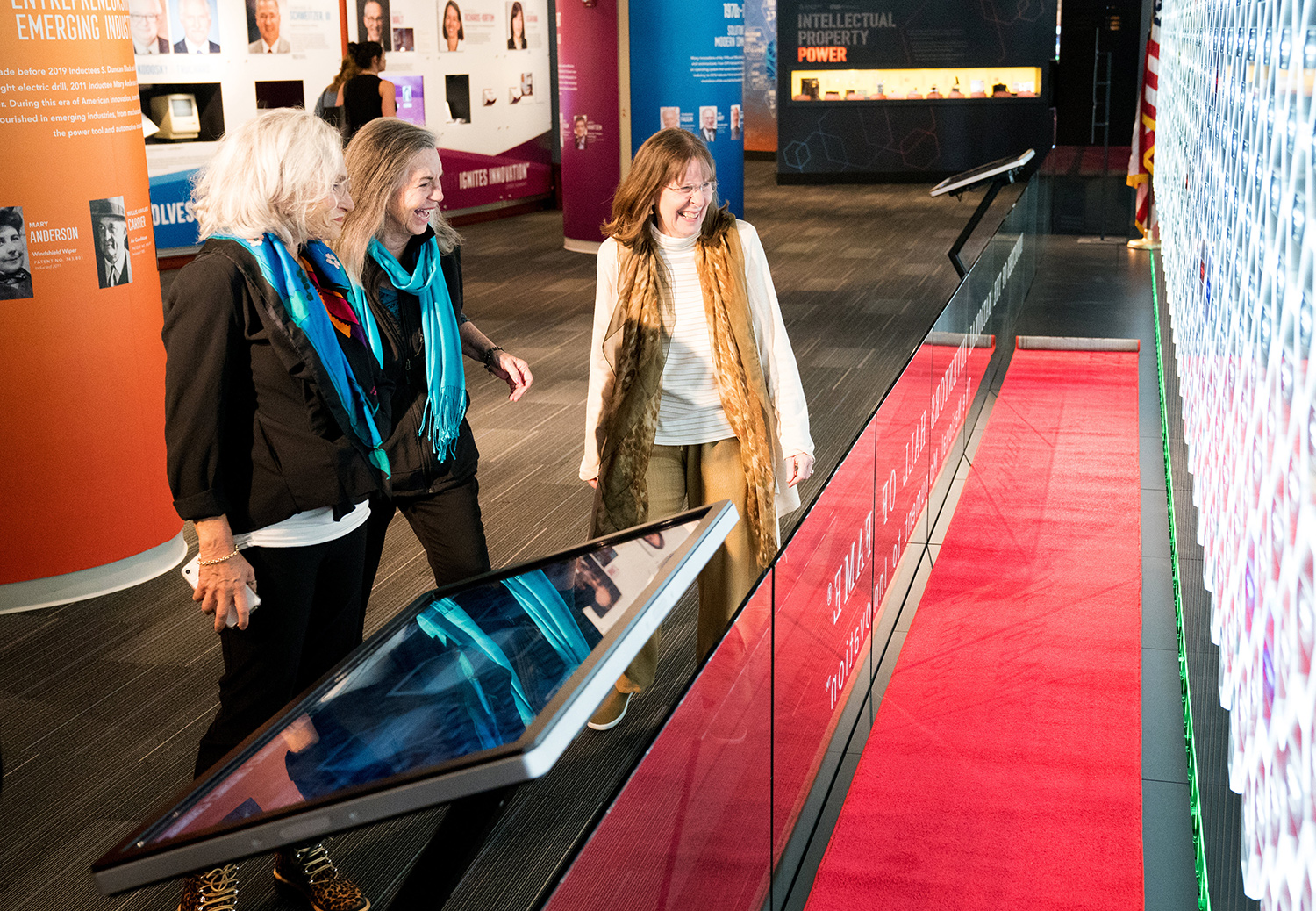
Left to right: Hinda Miller, Lisa Lindahl, and Polly Smith view the Gallery of Icons during their visit to the National Inventors Hall of Fame Museum in Alexandria, Virginia, on March 3, 2020. Photo by Jay Premack/USPTO.
“Polly was living with me, and when I asked her to help me make this bra,” Lindahl says, “she literally rolled her eyes. When we were in school together as kids, we both would cut gym class. Neither one of us were jocks. [Miller] was the jock. She was a skier, and she played basketball.”
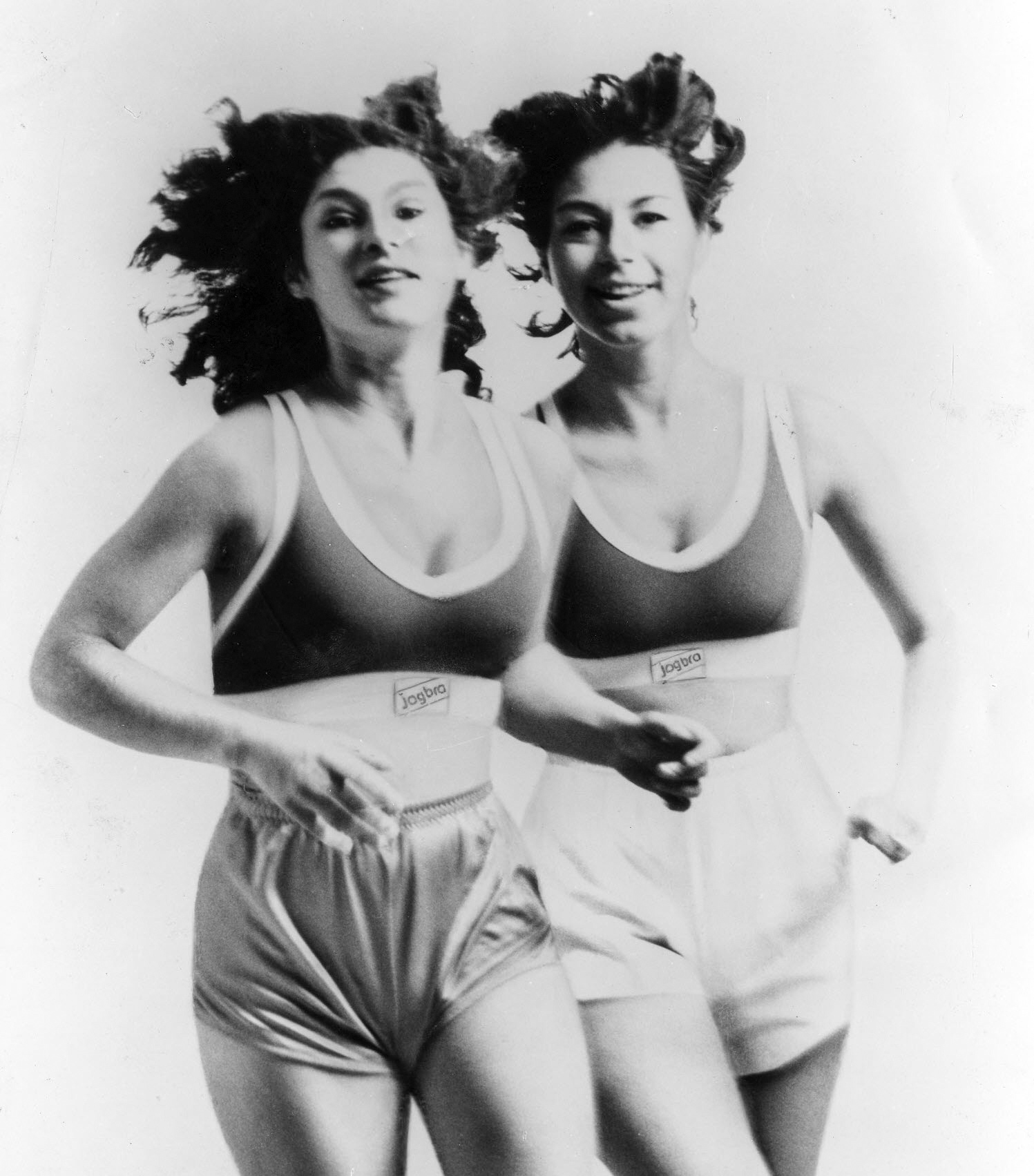
The early Jogbra ads featured inventors Hinda Miller (left) and Lisa Lindahl (right) running while wearing the Jogbra. Image courtesy of the National Museum of American History, Archives Center.
What had changed for Lindahl in the years since high school? “When I discovered running, it was a big ‘Aha!’ It empowered me. I became friends with my body, which was never the case before because I’ve had epilepsy all my life. My body and I had a complicated relationship, but running changed it. I loved it.”
Running did, however, present the same discomfort Lindahl and her sister had discussed. Before the Jogbra, Miller says, women “used elastic bandages to bandage their breasts, or we put our elbows to our chest when we ran because it felt better.” First and foremost, the new bra they were about to invent needed to eliminate that problem while running.
Getting the initial construction right was not easy, but inspiration was not long in coming. When it came, it was in the form of a crude joke. One day, while Lindahl and Smith were discussing their prototypes, Lindahl’s then-husband put a jockstrap over his chest and said, “Hey ladies, here’s your jock bra.”
“We thought that was so funny,” says Lindahl. After trying it on for herself, though, she realized they might have found what they were looking for.
“The problem was engineering the support. The jockstrap provided the engineering direction for what turned out to be the jock bra.” This realization led to the first successful prototype of the Jogbra, which was two jockstraps sewn together. Miller adds, “What we came upon was the fact that you could support the breasts by moving the weight closer to your center of gravity. Also, the breast was supported by the chest wall.”
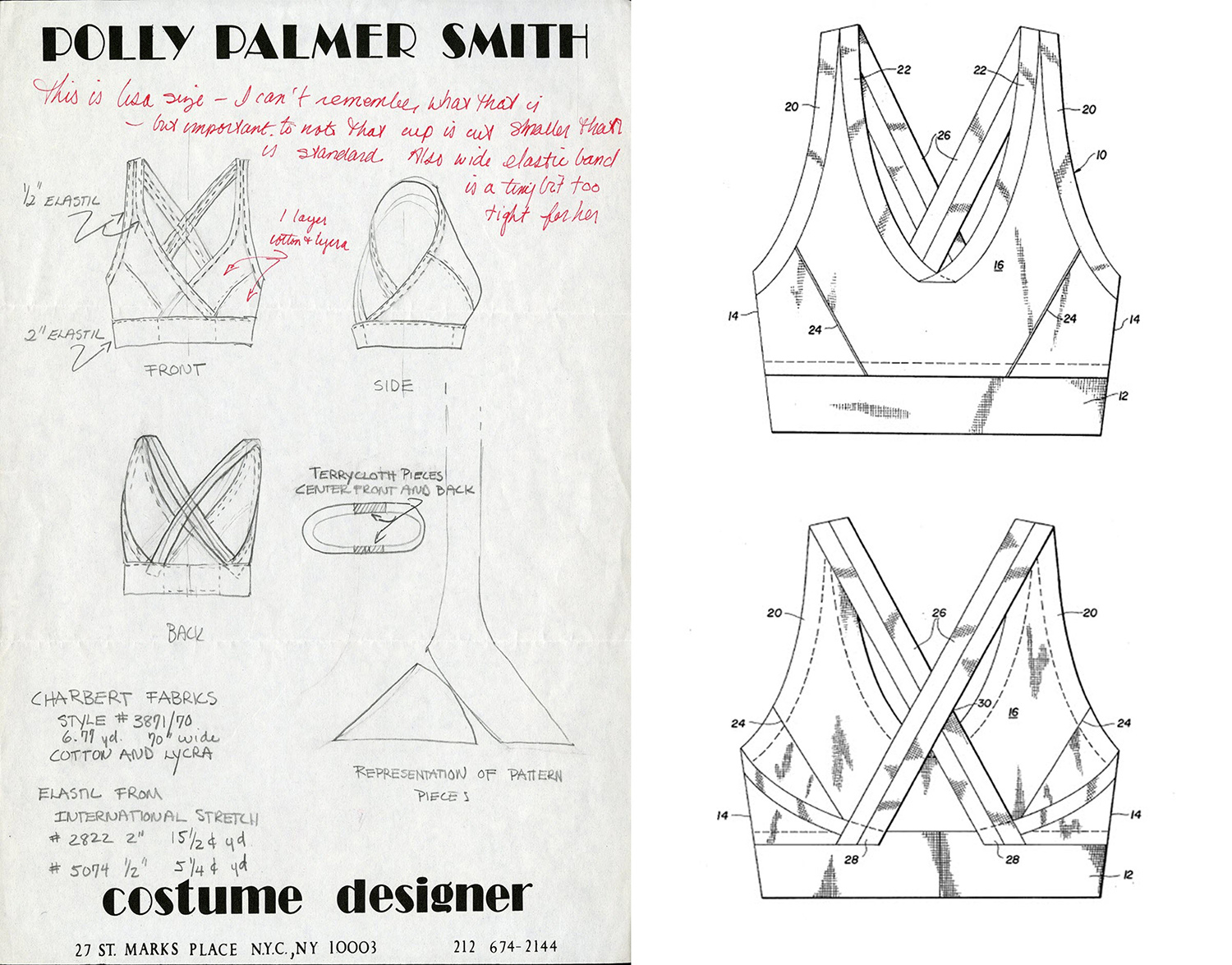
Shortly after helping to create the original Jogbra, Polly Smith accepted a job in costume design with the Jim Henson Co. and went on to win seven Emmy awards for her work. While she did not hold an active role in Jogbra Inc., she was instrumental to the Jogbra’s creation. On the left are her original sketches of the Jogbra. On the right are two drawings that appeared in U.S. Patent No. 4,174,717. Smith’s sketches are courtesy of the National Museum of American History, Archives Center.
To protect their invention and sell their product, the three women knew they needed to patent their idea right away. Unsure of how to start, it was a chance meeting that got them on the right track.
“I had gone to the post office,” Lindahl says, “and there’s a long line. The guy in front of me—we started chatting, and somehow the fact that I was looking for a patent attorney came up.” When she asked if he knew any good patent attorneys in Burlington, the man immediately said, “No, not in Vermont. Don’t even waste your time. Go right to Washington, D.C. That’s where all the good patent attorneys are.” He gave Lindahl the name and phone number of an attorney, and she called the number right after leaving the post office. Miller worked with Lindahl and Smith to create content for the patent, and she is still in touch with that patent attorney to this day.
Lindahl and Miller founded the first women-owned sporting goods business, Jogbra Inc., in 1977. They received their patent for the Jogbra on November 20, 1979, and U.S. Trademark No. 1,205,532 on August 17, 1982. Even with their own company, a patented product, and a trademarked brand, Lindahl and Miller needed to think strategically about where and how to launch their product. Though it was a bra, Lindahl says they weren’t thinking about it as a bra business.
“There had been no increase in bra sales in over a decade. The reason was that all of us women at the time—we weren’t buying any bras. We were burning them, if not literally, then metaphorically. They were just sitting in drawers and certainly not being bought."
![Jogbra Inc business card Lisa Zobain-Lindahl President 24 Clarke Street, Burlington, Vermont 05401 [802] 863-3548](/sites/default/files/styles/medium/public/2020-06/business-card.jpg?itok=YYSppUDR)
One of Lindahl’s original business cards, featuring the Jogbra trademark. Image courtesy of the National Museum of American History, Archives Center.
“The bra industry sold in department stores, and we instinctively knew we [couldn’t] play with those guys,” says Lindahl. The Jogbra was athletic equipment women needed for running; therefore, “we put it into the store[s] where we bought our running shoes, which was small franchises,” says Miller.
Surprisingly, the women believe their business would never have existed if they had done market research beforehand. According to Lindahl, “There had been no increase in bra sales in over a decade. The reason was that all of us women at the time—we weren’t buying any bras. We were burning them, if not literally, then metaphorically. They were just sitting in drawers and certainly not being bought."
“The most important thing was that we were designing for ourselves and we were designing for our friends,” says Miller. “We just came from what we needed. We listened to people around us.”
Lindahl feels this concept is important for young inventors today: “I think it’s really important to say—especially in this information age—don’t feel like you have to know everything before you take action. I think people get crippled by thinking they have to have all their ducks in a row. That’s a killer for the creative process.” In fact, Lindahl points out that in 1977 they had no idea they were the first women-owned sporting goods business.
“We didn’t know what we didn’t know. I remember walking around on this trade show floor, and every other woman there was either a wife, a secretary, somebody’s daughter, [or] a model.”

The front and back of the Jogbra sports bras packaging circa 1989. Image courtesy of the National Museum of American History, Archives Center.
“We had to spend money to educate people why they needed a sports bra. To be the first in a category, you have to tell people why [they] have to buy it."
Being first came with its own set of challenges. “We had to spend money to educate people why they needed a sports bra,” says Miller. “To be the first in a category, you have to tell people why [they] have to buy it. So, we had a nude profile of a young woman, and that was very risqué at the time. We explained why it needed a sports bra.” Another challenge was proving their product’s worth to sales representatives.
“These reps worked for shoe companies, and they worked for big clothing companies,” Lindahl says. “How did we compete with them for their attention and their passion so that when they went into a store, they left time to bring our stuff out of the bag?”
“And the way, I felt,” continues Lindahl, “was by having a different sort of relationship with them. We came to know them, were their friend. … And we had fun. We had ski races. We brought them to Vermont, and we did things like get on the stage and perform the Jogbra rap. We were not distant suits behind a podium.” Lindahl and Miller’s marketing efforts clearly paid off: by the end of their first year, Jogbra’s sales reached $500,000 and continued to grow steadily in the years to come—and they were profitable.
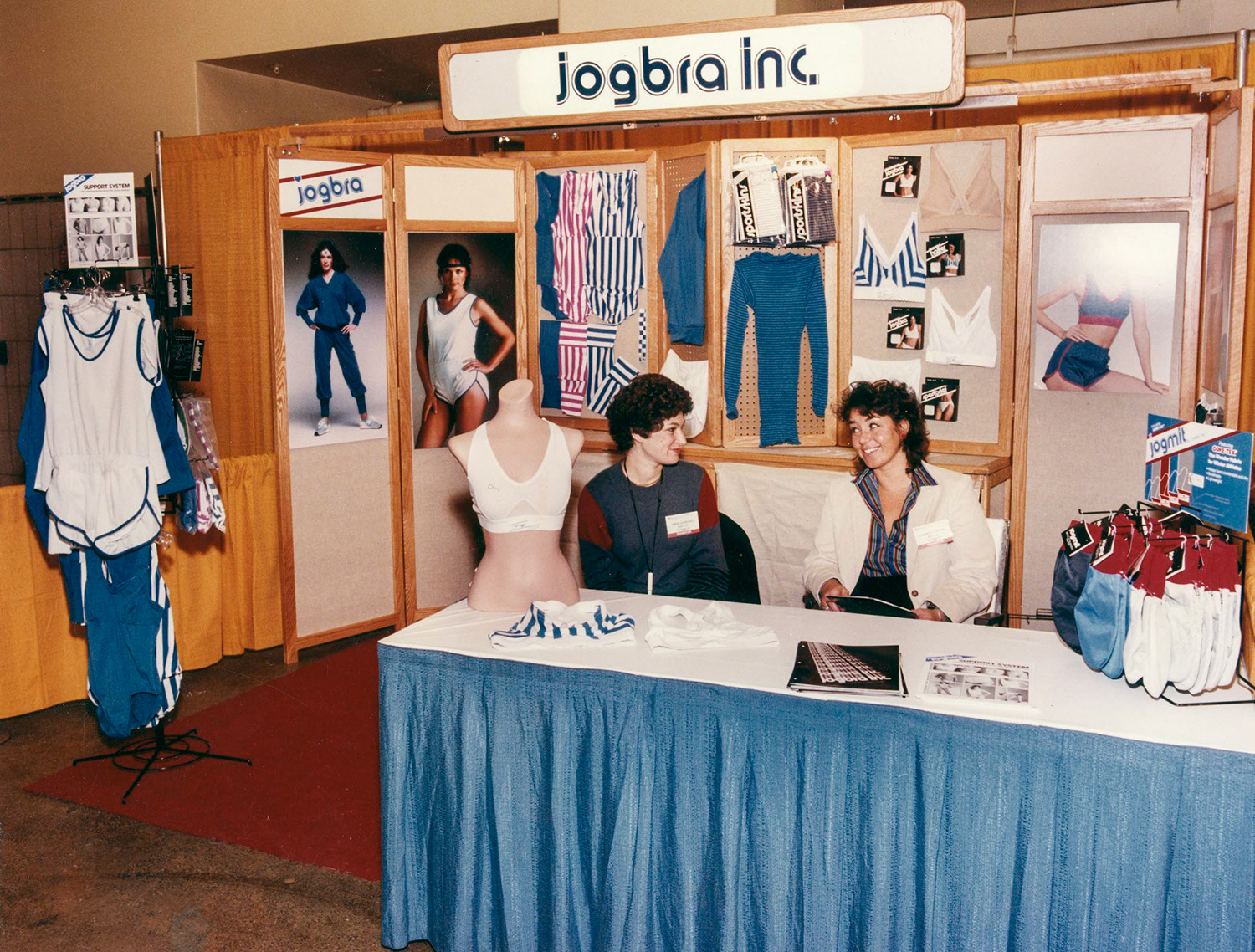
Hinda Miller (left) and Lisa Lindahl (right) represent their company and merchandise at a Jogbra Inc. exhibit in 1981. In addition to Jogbras, the company later developed other products, including Sportops, Jogmits, and Sportskins. Image courtesy of the National Museum of American History, Archives Center.
When they were sewing and creating the Jogbra, Smith, Lindahl, and Miller never imagined it would have an impact of this magnitude.
“Because my career went in an entirely different direction, I didn’t give a lot of thought to the sports bra industry or my part in it—except when I’d see women in sport bras strutting around my gym,” says Smith. “Then perhaps I’d be a little smug.”
What started out as an attempt to decrease discomfort while running turned into—and continues to be—a story of female empowerment and professional advancement.
In addition to their first patent, Lindahl, Miller, and Smith received two more patents relating to the Jogbra: U.S. Patent Design No. 259,370, and U.S. Patent No. 4,311,150. In 1981, Lindahl and Miller also received U.S. Patent Design No. 260,445 for the athletic shirt. “What I didn’t realize was that we would create jobs for women,” said Miller. “We saw women move up our ranks.” Jogbra Inc. was renamed JBI Inc. in the early 1980s, and their company size grew to approximately 200 people by the time Lindahl and Miller sold it to Playtex Apparel Inc., in 1990. They served as co-presidents of the Jogbra division until 1991 when Lindahl left the company.
Miller stayed on, and the Sara Lee Corporation bought Jogbra from Playtex in 1991. In 1994, Miller became the chief executive officer of Sara Lee’s Champion Jobgra division until she left the company in 1997. In 2000, she was named on U.S. Patent No. 6,083,080 for the protective brassiere with local energy absorption.
“I had no idea that my personal experience of being transformed and empowered through running… that this garment could do that for so many others,” says Lindahl, who, in addition to several other patents, was named on U.S. Patent No. 7,922,682 in 2011 for the method of providing compressive forces to a human torso. “It wasn’t until someone called me and said, ‘Do you understand how your invention has empowered all these young women?’ And then I began to get it and say, ‘I need to take this seriously.’”
“I often point out to [students] how beneficial it was for me to be a hands-on builder and craftsperson at every stage of my career."
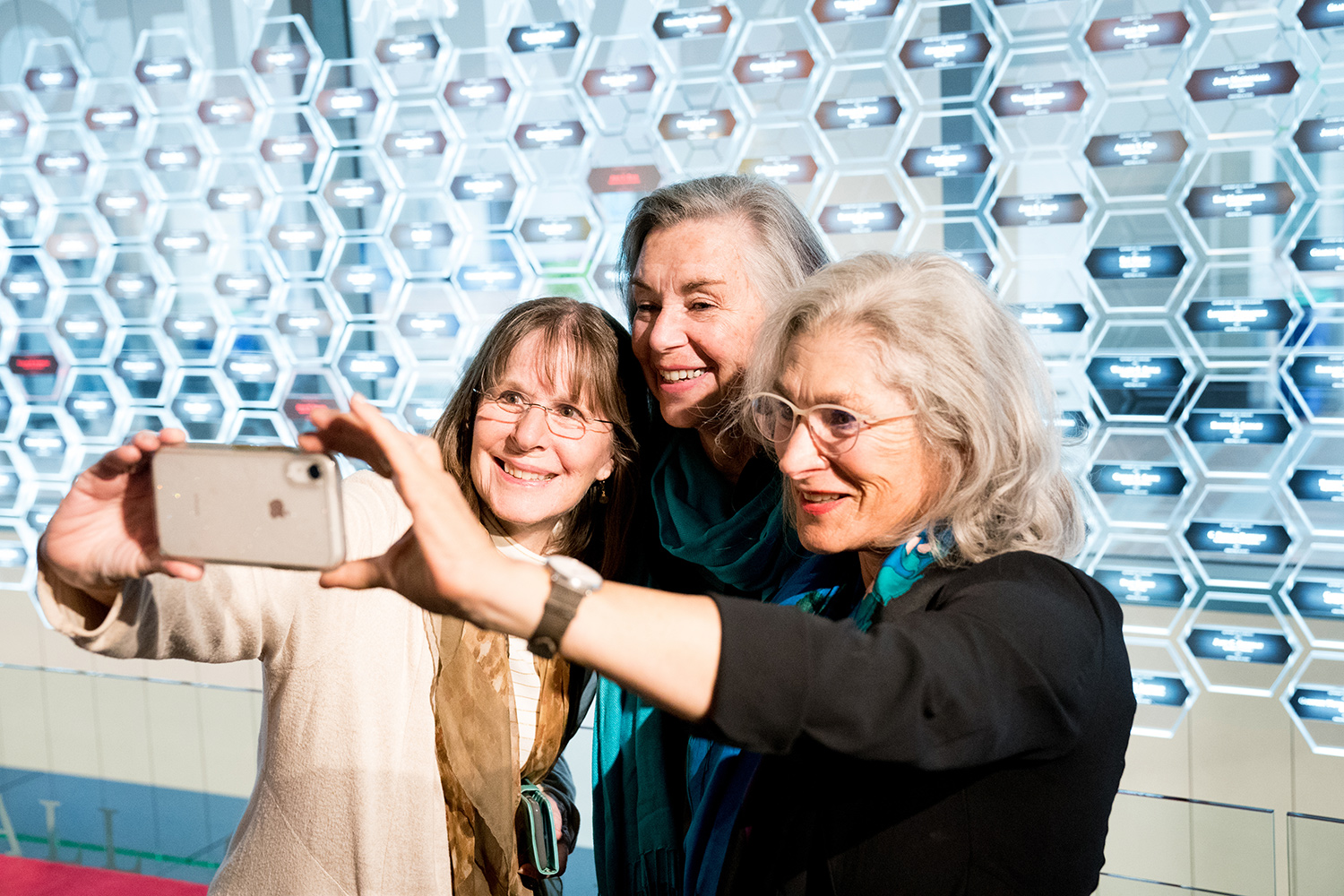
Left to right: Polly Smith, Lisa Lindahl, and Hinda Miller take a selfie during their visit to the National Inventors Hall of Fame Museum in Alexandria, Virginia, on March 3, 2020. Photo by Jay Premack/USPTO.
Smith talks to many students who are interested in a career as a costume designer: “I often point out to them how beneficial it was for me to be a hands-on builder and craftsperson at every stage of my career. I was always employed before I was given productions of my own to design and, later on, better able to direct others who were constructing my designs."
Invented on the heels of Title IX, which prohibited sex discrimination in educational institutions that receive federal funding, the change the Jogbra inspired is not lost on the women.
“Our vision was that no matter what your shape, size, or age, every woman and girl had the right to the benefits of exercise.”
“I’m most proud of the fact that we were part of a generation that started sports and fitness for women,” says Miller. “Our vision was that no matter what your shape, size, or age, every woman and girl had the right to the benefits of exercise.” They are also confident this vision will continue to grow beyond their part in it.
“The concept and the dynamic that [the sports bra] performs for women and girls has had this whole life of its own,” says Lindahl. Miller adds that women “are demanding comfort and fit.” She pointed out that just as women’s underwear represented the “social, political, and economic status of women” throughout history, the sports bra continues to contribute to the “evolution of women.”
For their contributions to the female sports equipment industry, Lindahl, Miller, and Smith were inducted into the National Inventors Hall of Fame in 2022.
In her acceptance speech, Lindahl — who was diagnosed with epilepsy at age 4 — said she hopes her recognition "serves to inspire and empower other women and girls like me with a disability. It is often that very disability, that differently abled, that births the new and different perceptions, new ways of looking at old problems, [and creates] new solutions for our world and for the future of our children."
Credits
Produced by the USPTO’s Office of the Chief Communications Officer. For feedback or questions, please contact inventorstories@uspto.gov.
Story by Lauren Emanuel. Contributions from Marie Ladino, Eric Atkisson, and Jay Premack. Photo at the beginning of this story and on the USPTO homepage by Jay Premack/USPTO.
References
“Hinda Miller.” National Inventors Hall of Fame, https://www.invent.org/inductees/hinda-miller.
Jogbra, Inc. Records, Archives Center, National Museum of American History, Smithsonian Institution, https://sova.si.edu/details/NMAH.AC.1315.
“Lisa Lindahl.” National Inventors Hall of Fame, https://www.invent.org/inductees/lisa-lindahl.
McGrath, Maggie, “Women supporting women: the inspiring story behind one of the 20th century’s least-appreciated innovations—the sports bra.” Forbes.com, March 6, 2020, https://www.forbes.com/sites/maggiemcgrath/2020/03/06/women-supporting-….
“Polly Smith.” National Inventors Hall of Fame, https://www.invent.org/inductees/polly-smith.
Rosenwald, Michael S., “Brandi Chastain’s sports bra changed women’s soccer—and women’s history—20 years ago.” Washington Post, July 7, 2019, https://www.washingtonpost.com/history/2019/07/05/brandi-chastains-spor….
Weinstein, Bob, “Off and running.” Entrepreneurial Woman, January/February 1991, http://edan.si.edu/slideshow/viewer/?eadrefid=NMAH.AC.1315_ref230.



